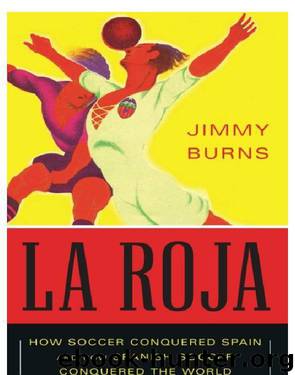La Roja: How Soccer Conquered Spain and How Spanish Soccer Conquered the World by Jimmy Burns

Author:Jimmy Burns
Language: eng
Format: mobi, epub
Tags: Europe, Non-Fiction, Spain & Portugal, Football, Sports & Recreation, General, Soccer, History
ISBN: 9781568587172
Publisher: Nation Books
Published: 2012-05-29T04:00:00+00:00
Herrera expressed his disappointment publicly on behalf of the team—without directly raising the issue of politics, still less blaming Franco. The official rumor mill suggested that this had little to do with any sense of patriotic opportunity or love of soccer but rather the loss of the financial bonuses Herrera had been promised by the Spanish Federation as an incentive to beat the Russians. Abroad it did little to improve Franco’s image among his critics. The London Times condemned what it described as Franco’s arbitrary and blatantly political coercive act that had violated the founding principles of the International Olympic Committee and FIFA. The newspaper suggested, not inaccurately, that Franco was making a point about Spain’s credentials as an anticommunist Cold War warrior as a way of impressing his military and commercial ally, the United States. It certainly had very little to do with soccer.
Herrera survived for another two years as manager of the Spanish squad, but he made as many enemies as friends, and the former eventually caught up with him. The Argentine initially courted criticism for dropping Kubala from Barca first and then from the national squad, justifying the move on loss of form and lack of discipline linked to the Hungarian’s heavy drinking.
Herrera forced out not only Kubala, but also another legend of Spanish soccer—Pepe Samitier, the former star player–turned–technical director of FC Barcelona. After a row with Herrera, Samitier moved to Real Madrid, where he had as many friends as in the Catalan capital, not least Franco himself, and where he harbored an enduring grudge against the Argentine. By the time Spain qualified for the World Cup in Chile in 1962, Herrera had become, as Alfredo Relaño puts it, the “baddy of the film . . . for many an innovator, for others a real antiChrist of soccer.”
On paper the Spanish squad that qualified for the World Cup in Chile in 1962, with Herrera as coach, could only impress, such was the talent and experience displayed. It included four nationalized foreigners—Di Stéfano, the Uruguayan-born Real Madrid central defender José Santamaría, Puskás, and Barca’s Paraguayan-born striker Eulogio Martínez—together with a coterie of homegrown stardom that included Gento, Collar, Peiro, Garay, Adelardo, and Del Sol. Yet Spain did not get past the first round where it was grouped together with Mexico and the two eventual finalist runners-up Czechoslovakia and Brazil, which won the championship.
As Brian Glanville has written, the component pieces of the Brazil team had “sprung apart, then strangely and steadily come together again.” During the four years since they had last won the World Cup, two key Brazilian players had played at the club level in the Spanish Liga with contrasting fortunes. Vava, who scored twice in the 1958 final, went on to have two successful seasons with Atletico de Madrid. The other was Didi, one of the few foreign stars brought in by Bernabéu who did not prove a success at Real Madrid, partly because he never seemed to be quite up to the energy and speed of his teammates and partly because of personal problems involving his wife.
Download
La Roja: How Soccer Conquered Spain and How Spanish Soccer Conquered the World by Jimmy Burns.epub
This site does not store any files on its server. We only index and link to content provided by other sites. Please contact the content providers to delete copyright contents if any and email us, we'll remove relevant links or contents immediately.
The Inner Game of Tennis by W. Timothy Gallwey(3576)
Unstoppable by Maria Sharapova(3484)
Urban Outlaw by Magnus Walker(3343)
Crazy Is My Superpower by A.J. Mendez Brooks(3334)
Mind Fuck by Manna Francis(3132)
The Social Psychology of Inequality by Unknown(2941)
The Fight by Norman Mailer(2849)
Unstoppable: My Life So Far by Maria Sharapova(2456)
Accepted by Pat Patterson(2309)
Futebol by Alex Bellos(2301)
Going Long by Editors of Runner's World(2298)
Motorcycle Man by Kristen Ashley(2200)
Sea Survival Handbook by Keith Colwell(2199)
Backpacker the Complete Guide to Backpacking by Backpacker Magazine(2194)
The Happy Runner by David Roche(2194)
The Sports Gene: Inside the Science of Extraordinary Athletic Performance by David Epstein(2135)
Peak: Secrets from the New Science of Expertise by Anders Ericsson & Robert Pool(1989)
Endure by Alex Hutchinson(1968)
The Call of Everest by Conrad Anker(1868)
